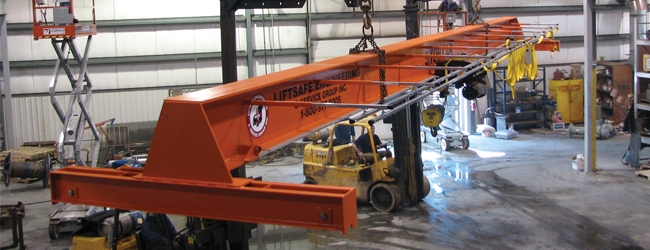Related to: How to Extend the Life of Your Overhead Crane, A General Overview of Overhead Cranes, The Importance of Load Testing Overhead Cranes and Hoists, The Benefits of Modernizing Your Crane
The importance of overhead crane safety cannot be stressed enough. Cranes and hoists are fundamental tools in the construction industry for a variety of applications. Accidents, property damage and fatalities occur every year due to improper use of cranes and equipment failure. Identifying hazards and adhering to simple inspection and safety guidelines can greatly reduce the probability of these unfortunate occurrences.
5 Risks you should be looking for:
- Overloading. Although it may seem very straightforward to never overload a crane past its weight capacity; it often occurs when an experienced operator decides to trust their instincts about the weight of the load that their crane can lift. Not adhering to safety procedures presents the risk of the crane collapsing and toppling over. To help prevent overloading, make sure you use load measuring systems and other similar pieces of technology.
- Falling Materials. At any construction site, there is always a risk of falling materials. Causes of falling materials can include visual impairment, incompetence on behalf of the crane operator, mechanical failure, and slippage. Although workers must always wear their hard hats and engage in personal safety measures, it is often not enough to avoid many of the injuries and fatalities that are associated with falling materials.
- Braking Issues. This reliance on second brakes is a huge contributing factor to the risk of falling materials. To ensure that the crane will continue to hold its load if the power goes out, all cranes and electric hoists are required to have primary and secondary brakes. Electric hoists will have a fail-safe disc brake or drum brake. See note at the bottom of this blog for more information about secondary brakes.
- Side Pull. According to the Hoist Manufacturers Institute and Crane Manufacturers Association of America, cranes and hoists are designed to lift straight up and straight down. A side pull can cause the wire rope to scrape against the remaining rope or drum if it falls out of its groove, causing the wire to become damaged which in turn creates a greater risk of the rope breaking when in use. It is not uncommon for the rope to jump the drum itself, resulting in additional stress being placed on the rope and twisting around the shaft.
- Electrical Hazards. It is standard to always assume that all power lines are live because coming into contact with a line can be deadly. Ensure that you identify a safe distance from any potentially live wire, and mark the area with signs and tape. These markings can be beneficial in providing a visual aid to the crane operator so they can be aware of the potential hazard. The safe distance between operators and power lines can be determined by your local safety regulations. To prevent electrical dangers, pre-job safety training is imperative.
It Is Important to Note That…
Secondary Brakes are not Fool Proof. It does not matter whether the load takes a controlled fall or just drops it is never safe to walk underneath a load. For correct overhead crane safety, the operator should never rely on the assistance of secondary brakes.
What are the secondary brakes? The two primary types of secondary brakes are regenerative brakes and mechanical load brakes. Regenerative brakes are most commonly used but are not manufactured to hold the load as a result of primary brake failure; they will, however, lower the load at the normal operating speed. Mechanical load brakes are uncommon because they produce a lot of heat and are costly when compared to regenerative brakes.
Daily Overhead Crane Inspections:
Daily inspections are a fundamental aspect of overhead crane safety. A simple safety check requires the operator to carefully examine the crane with their eyes and ears then keep a record of their findings. Visual Surveys confirm if: the crane might need repair, the area is clear and if in general, the crane looks operational. A qualified operator can determine a lot by listening to the crane, including sounds what the crane should and should not sound like when running up the bridge movement and hoist or trolley.
Crane operators must make sure that the hoist is working in all directions and that the dimensions of the buttons match its movement. Making sure that end stops are in place and functioning is of the utmost importance. If the power phases happen to be reversed, safety circuits will be disabled and all of the directional buttons may be wrong.
It only takes a few minutes a day to adhere to OSHA requirements and perform daily inspections on cranes. However, not everyone does this. All this task consists of is a crane operator checking a simple checklist, and it does not even require any special maintenance personnel!
Daily Crane Inspections are a simple step in overhead crane safety and crucial to preventing injuries and property damage. By performing daily inspections, paying attention to potential risks and using common sense the accidents associated with overhead crane use are easily preventable.


